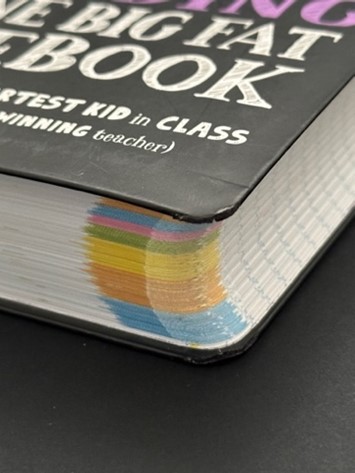
This hardcover case bound book has one distinctive that’s stuck out to me. Yes, it has rounded spine. Yes, the headband matches the colour of the spine. Yes, the end papers are printed. Yes, the corners are round. What’s unusual and I’ve never seen this before. Often on the face pages, you see different colours which functions as an index. Much cheaper than tabs. What’s distinct about this book as you can see in the picture is the lower right corner is all the different colours. Each colour represents a different division of book, I’ve never seen one like this before. It doesn’t effect the binding cost. Another idea to help sell a book.
Innovative Binding Techniques: The Benefits of Coloured Corners in Bookbinding
In the world of bookbinding and finishing, innovation and creativity play a crucial role in setting products apart. One such innovative technique that has recently gained attention is the use of coloured corners in hardcover case bound books. This article explores the advantages of coloured corners from a binding and finishing company’s perspective, and how this distinctive feature can add value to the finished product.
What are Coloured Corners?
Coloured corners refer to the application of different coloured materials or inks to the corners of the pages in a book. This technique can be particularly eye-catching and functional, especially when used strategically to signify different sections or chapters within the book. It’s an innovative alternative to traditional indexing methods like tabs.
The Unique Appeal of Coloured Corners
In a recent project, a hardcover case bound book featured several unique aspects that caught the attention of our team. The book had a rounded spine, matching headbands, and printed endpapers – all hallmarks of a high-quality binding job. However, what stood out most were the coloured corners. Each lower right corner was printed in a different colour, representing various divisions of the book. This not only added a visually appealing element but also served a functional purpose.
Advantages of Coloured Corners
1. Enhanced Navigation
Coloured corners serve as a visual index, making it easier for readers to navigate through the book. By assigning a unique colour to each section, readers can quickly find the information they are looking for without the need for traditional tabs. This can be particularly beneficial in educational textbooks, reference materials, and manuals where quick access to specific sections is essential.
2. Cost-Effective
Implementing coloured corners is a cost-effective solution compared to adding physical tabs. Tabs can increase the overall production costs and may affect the binding process. On the other hand, coloured corners do not impact the binding cost significantly, making it an economical choice for publishers and authors looking to add a unique feature to their books.
3. Aesthetic Appeal
From a design perspective, coloured corners add an element of sophistication and uniqueness to the book. This can be a selling point for special editions, gift books, and premium publications. The vibrant colours at the corners can catch the eye of potential buyers, making the book stand out on the shelf.
4. Durability and Practicality
Unlike tabs that can be prone to tearing or bending, coloured corners are more durable. They do not add any extra material to the pages, ensuring that the book maintains its structural integrity. This makes coloured corners a practical choice for books that are frequently used or handled.
Case Study: Coloured Corners in Action
In the highlighted project, the use of coloured corners was a new and exciting addition. Each division of the book was represented by a different colour at the lower right corner. This method proved to be a brilliant way to help readers quickly identify sections without compromising the book’s aesthetic or adding significant production costs.
Conclusion
Coloured corners offer a unique blend of functionality, cost-effectiveness, and aesthetic appeal. For binding and finishing companies, this technique provides an innovative way to enhance the value of a book. By incorporating coloured corners, companies can offer their clients a distinctive product that stands out in the market.
As the industry continues to evolve, embracing such creative techniques will be key to staying ahead of the competition. Coloured corners are a testament to how small details can make a significant impact, providing an excellent example of innovation in bookbinding and finishing.
Whether you’re a publisher looking to add a special touch to your next project or a binding company aiming to offer new solutions to your clients, coloured corners are worth considering. This small yet impactful detail can make all the difference in creating a memorable and functional book.
